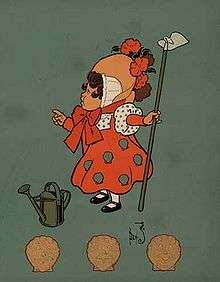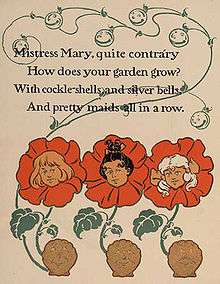Mary, Mary, Quite Contrary
| "Mary, Mary, Quite Contrary" | |
|---|---|
 Illustration by William Wallace Denslow | |
| Nursery rhyme | |
| Published | c. 1744 |
"Mary, Mary, Quite Contrary" is a popular English nursery rhyme. The rhyme has been seen as having religious and historical significance, but its origins and meaning are disputed. It has a Roud Folk Song Index number of 19626.
Lyrics

The most common modern version is:
Mary, Mary, quite contrary,
How does your garden grow?
With silver bells, and cockle shells,
And pretty maids all in a row.[1]The oldest known version was first published in Tommy Thumb's Pretty Song Book (1744) with the following lyrics:
Mistress Mary, Quite contrary,
How does your garden grow?
With Silver Bells, And Cockle Shells,
And so my garden grows.[1]Several printed versions of the 18th century have the lyrics:
The last line has the most variation including:
Cowslips all in arow [sic].[1]and
With lady bells all in a row.[1]Explanations
Like many nursery rhymes, it has acquired various historical explanations. These include:
- That it is a religious allegory of Catholicism, with Mary being Mary, the mother of Jesus, bells representing the sanctus bells, the cockleshells the badges of the pilgrims to the shrine of Saint James in Spain (Santiago de Compostela) and pretty maids are nuns, but even within this strand of thought there are differences of opinion as to whether it is lament for the reinstatement of Catholicism or for its persecution.[1]
- Another theory sees the rhyme as connected to Mary, Queen of Scots (1542–1587), with "how does your garden grow" referring to her reign over her realm, "silver bells" referring to (Catholic) cathedral bells, "cockle shells" insinuating that her husband was not faithful to her, and "pretty maids all in a row" referring to her ladies-in-waiting – "The four Maries".[1] In Disney's The Truth About Mother Goose the "silver bells" are said to "refer to the elaborate decoration on her dresses", the "cockle shells" to her love of exotic food such as cockles, with the "pretty maids all in a row" referring to her ladies-in-waiting.[2]
- Mary has also been identified with Mary I of England (1516–1558) with "How does your garden grow?" said to refer to her lack of heirs, or to the common idea that England had become a Catholic vassal or "branch" of Spain and the Habsburgs. It is also said to be a punning reference to her chief minister, Stephen Gardiner. "Quite contrary" is said to be a reference to her unsuccessful attempt to reverse ecclesiastical changes effected by her father Henry VIII and her brother Edward VI. The "pretty maids all in a row" is speculated to be a reference to miscarriages or her execution of Lady Jane Grey. "Rows and rows" is said to refer to her executions of Protestants.[3]
No proof has been found that the rhyme was known before the 18th century, while Mary I of England and Mary, Queen of Scots, were contemporaries in the 16th century.[1][3]
In popular culture
The nursery rhyme has been referenced several times in popular culture.
- In 1923, Mrs. Fiske starred in a Broadway play with this title. It was written by St. John Ervine and co-starred Francis Lister.[4]
- The German rock band Can recorded a song released on their debut album Monster Movie (1969) named "Mary, Mary So Contrary", which improvises over its lyrics.
- The title of Roger Vadim's Pretty Maids All in a Row (1971) refers to a lyric from "Mary, Mary, Quite Contrary.[5]
- The Eagles recorded a song named Pretty Maids All in a Row on their album Hotel California (12/08/1976).[5]
- Roald Dahl parodied the nursery rhyme in his poetry book Rhyme Stew (1989), where Mary responds to the narrator that she is unable to tell how her garden grows, since: "I live with my brat in a high-rise flat, so how in the world should I know?!"
- Frances Hodgson Burnett used this nursery rhyme to describe the personality and mannerisms of Mary Lennox in her children's novel The Secret Garden (1911), where the other children at her temporary home with an English clergyman call her "Mary, Mary, Quite Contrary" and reference the rhyme.
Notes
References
- 1 2 3 4 5 6 7 8 Opie, Peter; Opie, Iona Archibald (1997) [1952]. The Oxford Dictionary of Nursery Rhymes. Oxford: Oxford University Press. p. 301. ISBN 0-19-860088-7. OCLC 229161681.
- ↑ The Truth About Mother Goose Disney (1957)
- 1 2 Roberts, Chris (2004). Heavy Words Lightly Thrown: The Reason Behind the Rhyme. London: Granta. pp. 33–34. ISBN 978-1592401307. OCLC 56646713.
- ↑ Internet Broadway Database (IBDb.com)..Retrieved January 2, 2018
- 1 2 http://nightflight.com/pretty-maids-all-in-a-row-roger-vadims-outrageous-early-70s-sex-and-murder-black-comedy/
- ↑ http://www.authorama.com/secret-garden-2.html